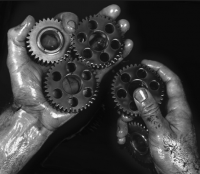








The cryotron is a switch that operates using superconductivity.The cryotron works on the principle that magnetic fields destroy superconductivity. This simple device consists of two superconducting wires (e.g. tantalum and niobium) with different critical temperature (Tc). The cryotron was invented by Dudley Allen Buck of the Massachusetts Institute of Technology Lincoln Laboratory.
As described by Buck,a straight wire of tantalum ( having lower Tc) is wrapped around with a wire of niobium in a single layer coil. Both wires are electrically isolated from each other. When this device is immersed in a liquid helium bath both wires become superconducting and hence offer no resistance to the passage of electric current. Tantalum in superconducting state can carry large amount of current as compared to its normal state. Now when current is passed through the niobium coil (wrapped around tantalum) it produces a magnetic field, which in turn reduces (kills) the superconductivity of the tantalum wire and hence reduces the amount of the current that can flow through the tantalum wire. Hence one can control the amount of the current that can flow in the straight wire with the help of small current in the coiled wire. We can think of the tantalum straight wire as a "gate" and the coiled niobium as a "control".
The article by Buck includes descriptions of several logic circuits implemented using cryotrons, including: one stage of a binary adder, carry network, binary accumulator stage, and two stages of a cryotron stepping register.
A planar cryotron using thin films of lead and tin was developed in 1957 by John Bremer at GE’s General Engineering Lab in Schenectady, New York, USA. This was one of the first integrated circuits, although using superconductors rather than semiconductors. In the next few years a demonstration computer was made and arrays with 2000 devices operated. A short history of this work is in the November 2007 newsletter of the IEEE History Center.
Matisoo developed a version of the cryotron incorporating a Josephson junction switched by the magnetic field from a control wire. He also explained the shortcomings of traditional cryotrons in which the superconductive material must transition between superconducting and normal states to switch the device, and thus switch relatively slowly.